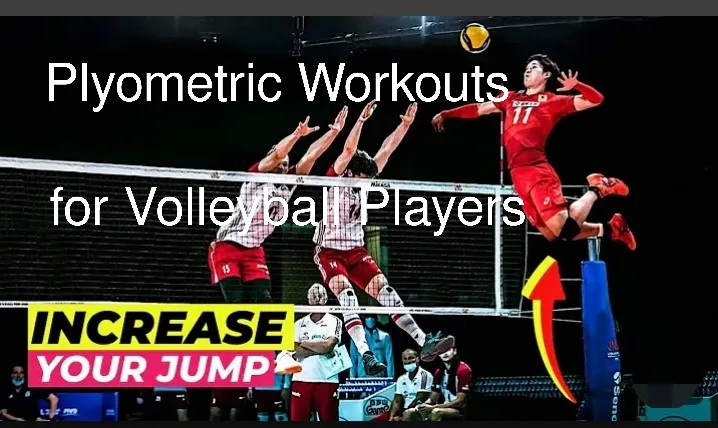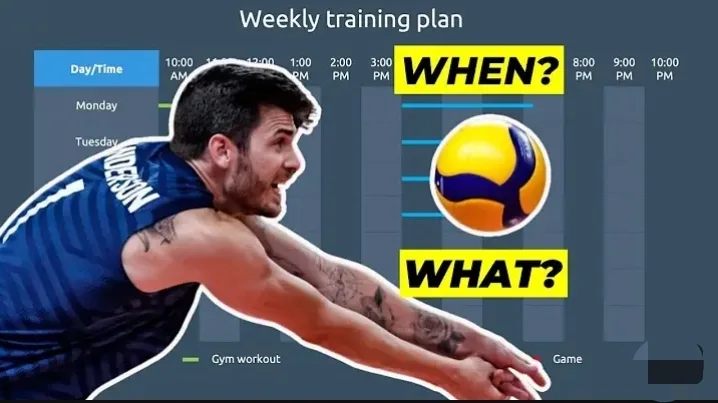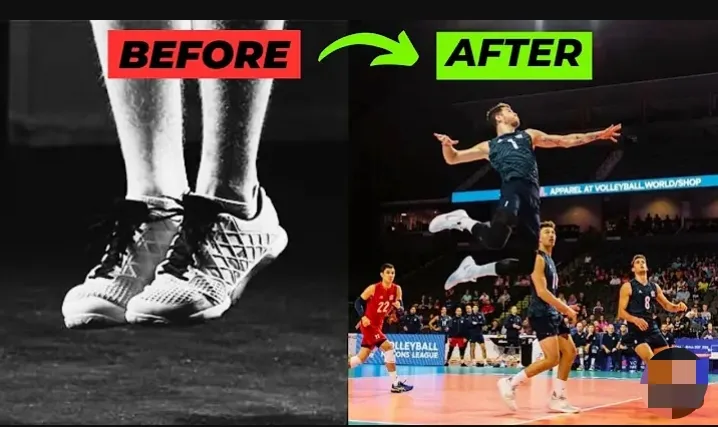Welcome! Today, we’re looking into the dynamic world of plyometric workouts for volleyball players. Plyometrics, or plyos, are explosive exercises designed to enhance muscle strength and power, essential for improving jump height and agility on the volleyball court.
In this article, you will discover the benefits of plyometric exercises, safety tips, and some effective plyometric workouts that are tailored to volleyball players that you can incorporate into your volleyball training routine.
Whether you’re a beginner or a seasoned player, these plyometric exercises can help take your game to the next level. Let’s get started!
What are Plyometric Workouts for Volleyball?
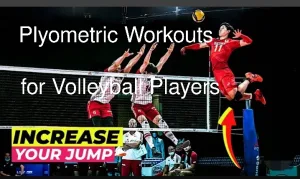
Plyometric workouts, or plyos, are explosive workouts designed to increase muscle strength and power, which are crucial for volleyball players looking to improve their jump height and agility.
Plyometric Workouts for Volleyball players are:
- Pop Squat
- Split Squat Jump
- Tuck Jump
- Jump Squat with Heel Tap
- Skater Hop
- Lateral Lunge to Single-Leg Hop
- Box Jump
- Burpee
These workouts focus on making the muscles stronger by generating a large amount of force in a short time, preparing the muscles for powerful and high-energy jumps.
See Also:
- Volleyball Workouts at Home and the Gym (7-day plan)
- 10 Best Volleyball Strength Exercises for Beginners
Benefits of Plyometric Exercises for Volleyball
- Increased Jump Height: Plyometrics help in pre-tightening the muscles before jumping, storing energy that can be used to jump higher and more energetically.
- Improved Speed and Agility: These exercises can help increase speed, endurance, agility, and coordination.
- Strengthens Tendons: Plyometric training can boost tendon strength and increase your rate of force development.
- Reduced Risk of Injury: Proper plyometric training can improve your body’s ability to quickly absorb shock, reducing the risk of injury during games or workouts.
Safety Tips for Plyometric Workouts
While plyometric exercises offer many benefits, they also come with a higher risk of injury due to their high-impact nature. Here are some safety tips to keep in mind:
- Master the Basics: Before adding plyometric elements, ensure you have mastered the basic form of the exercise.
- Focus on Landing Mechanics: Proper landing is crucial to preventing injuries. Land softly with your knees slightly bent, and avoid letting your feet smack the ground.
- Warm-Up Properly: Always warm up before starting plyometric exercises to prepare your body and reduce the risk of injury.
- Listen to Your Body: If you notice your form is faltering, lower the intensity of the exercise or take a break to prevent injury. For those interested in incorporating plyometric exercises into their volleyball training, it’s important to start slow and gradually increase intensity.
- Frequency: Beginners should start with one to two days a week of plyo work and gradually increase as they become more comfortable.
- Repetitions and Rest: Start with lower rep counts, around three to five reps, and ensure you give your body enough rest between sets to maintain good form.
Plyometric Workouts for Volleyball
Plyometric exercises are power exercises that involve quick and explosive movements. They are mainly about performing explosive movements at maximum effort. Plyos also challenge your strength and can count as cardio due to their high-intensity nature. Some of the plyometric workouts for volleyball players are:
1. Pop Squat
What is it? The pop squat is a plyometric workout that combines elements of a traditional squat with a jump. It’s designed to improve lower body strength, power, and explosive jumping ability.
Benefits:
- Improved Lower Body Strength: The pop squat targets the quadriceps, hamstrings, glutes, and calves, helping to strengthen and tone these muscle groups.
- Increased Power and Explosiveness: The explosive jump in the pop squat helps to develop fast-twitch muscle fibers, essential for quick and powerful movements on the volleyball court.
- Enhanced Jumping Ability: Regularly incorporating pop squats into a training routine can lead to an increase in vertical jump height, which is beneficial for spiking, blocking, and serving in volleyball.
- Improved Agility and Coordination: The quick transition from squat to jump enhances agility and coordination, skills that are crucial for moving quickly and efficiently around the court.
How to Do It:
- Starting Position: Stand with your feet wider than hip-width apart.
- Squat: Bend your knees and send your hips back to lower into a squat position. Bring your palms together in front of your chest to help maintain balance.
- Jump: Explosively push through your feet to jump up, bringing both feet together and hopping in place.
- Return to Squat: Immediately jump your feet apart and sink back into the squat position.
- Repetition: Continue performing the pop squat for the desired reps.
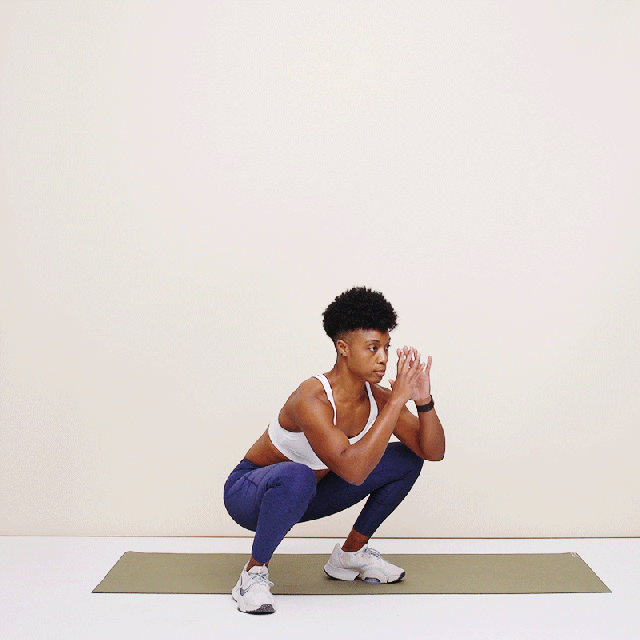
By: Katie Thompson
Importance of Pop Squat – Plyometric Workouts for Volleyball Players:
- The pop squat is particularly beneficial for volleyball players due to its focus on improving lower body strength and explosive power. These are essential for:
- Jumping Higher: A strong and explosive lower body is crucial for spiking, blocking, and jumping to reach high sets or serves.
- Quick Movement: Enhancing agility and coordination through pop squats can help players move quickly to react to the ball and change direction rapidly on the court.
- Reducing Injury Risk: Strengthening the lower body can help to support and stabilize the joints, reducing the risk of common volleyball-related injuries, such as ankle sprains and knee injuries.
Incorporating pop squats into a volleyball training routine can help players develop the necessary strength and power to excel in the sport, making it a valuable exercise for both beginner and advanced athletes.
2. Split Squat Jump
What is it?
The split squat jump is a plyometric workouts that targets the lower body, specifically the quadriceps, hamstrings, glutes, and calves.
It combines a stationary lunge with an explosive jump to enhance lower body strength, power, and vertical jumping ability.
Benefits:
- Increased Lower Body Strength: The split squat jump engages the major muscle groups in the lower body, leading to improved strength and muscle tone.
- Improved Explosive Power: The explosive jump in the exercise helps to develop fast-twitch muscle fibers, which are crucial for quick and powerful movements on the volleyball court.
- Enhanced Vertical Jump: Regularly including split squat jumps in a training routine can help volleyball players increase their vertical jump height, aiding in spiking, blocking, and serving.
- Enhanced Agility and Balance: The exercise challenges stability and balance, improving agility and coordination on the court.
How to Do It:
- Starting Position: Stand in a split stance with one foot positioned in front of the other, with your front knee bent at a 90-degree angle and your back knee lowered toward the ground.
- Jump: Explosively push through both feet to jump upward.
- Switch Legs: While in the air, switch the position of your legs, landing with the opposite foot in front.
- Repeat: Continue alternating the position of your legs with each jump.
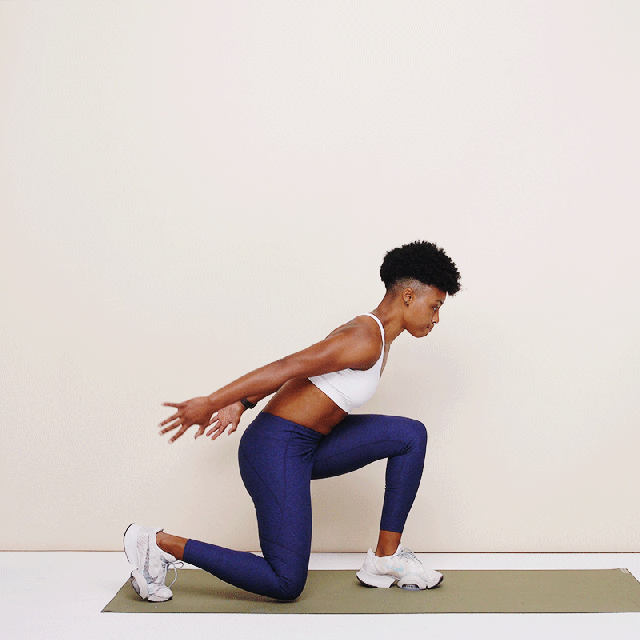
Image by: Katie Thompson
Importance to Volleyball Players:
The split squat jump is highly beneficial for volleyball players due to its focus on improving lower body strength, explosive power, and agility, which are essential for various aspects of the game.
- Spiking and Blocking: A strong and explosive lower body is vital for generating power in spikes and jumps for blocks.
- Vertical Jumping Ability: Enhancing the vertical jump through split squat jumps can help players reach higher when spiking and blocking, making them more effective on the court.
- Agility and Quick Movement: The exercise improves agility and coordination, enabling players to move quickly to react to the ball and change direction rapidly.
- Injury Prevention: Strengthening the lower body can help to support and stabilize the joints, reducing the risk of common volleyball-related injuries, such as ankle sprains and knee injuries.
Incorporating split squat jumps into a volleyball training routine can help players develop the necessary strength and power to excel in the sport, making it a valuable exercise for both beginner and advanced athletes.
See Also: 7 Volleyball Conditioning Drills: A Comprehensive Guide for Players
3. Tuck Jump
What is it?
The tuck jump is an advanced plyometric training that targets the lower body, core, and cardiovascular system. It involves jumping vertically and bringing the knees up towards the chest in a tuck position, enhancing explosive power, vertical jumping ability, and overall athleticism.
Benefits:
- Increased Lower Body Strength: The tuck jump engages the quadriceps, hamstrings, glutes, and calves, leading to improved strength and muscle tone.
- Enhanced Explosive Power: The explosive nature of the tuck jump helps develop fast-twitch muscle fibers, essential for quick and powerful movements on the volleyball court.
- Improved Vertical Jump: Regularly incorporating tuck jumps into a training routine can lead to an increase in vertical jump height, which is beneficial for spiking, blocking, and serving in volleyball.
- Enhanced Core Strength: The tuck jump engages the core muscles, helping to improve overall core strength and stability.
- Increased Agility and Coordination: The exercise challenges balance and coordination, enhancing agility and quickness on the court.
How to Do It:
- Starting Position: Stand with your feet shoulder-width apart.
- Jump: Explosively push through your feet to jump up.
- Tuck: While in the air, bring both knees up towards your chest, hugging them with your arms to hold the tuck position.
- Land: Extend your legs and land softly on the balls of your feet to absorb the impact.
- Repeat: Immediately perform another tuck jump upon landing, continuing for the desired reps.
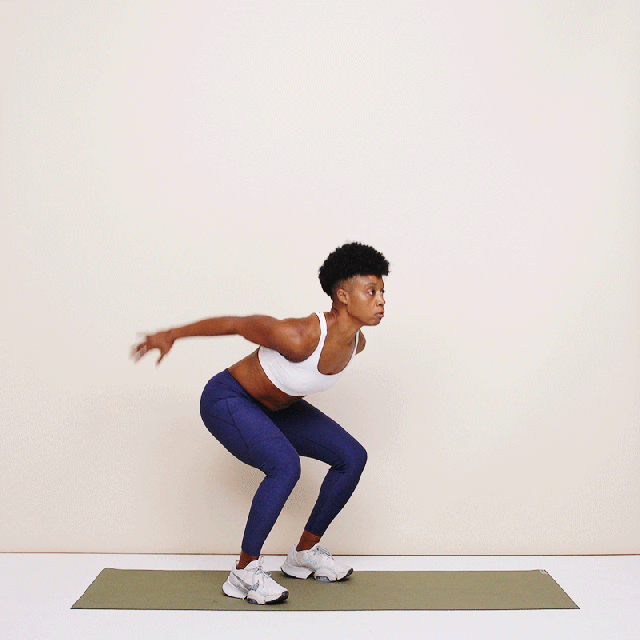
Image: Katie Thompson
Importance to Volleyball Players:
The tuck jump is particularly beneficial for volleyball players due to its focus on improving lower body strength, explosive power, and vertical jumping ability, which are essential for various aspects of the game.
- Spiking and Blocking: A strong and explosive lower body is vital for generating power in spikes and jumps for blocks.
- Vertical Jumping Ability: Enhancing the vertical jump through tuck jumps can help players reach higher when spiking and blocking, making them more effective on the court.
- Agility and Quick Movement: The exercise improves agility and coordination, enabling players to move quickly to react to the ball and change direction rapidly.
- Injury Prevention: Strengthening the lower body can help to support and stabilize the joints, reducing the risk of common volleyball-related injuries, such as ankle sprains and knee injuries.
Incorporating tuck jumps into a volleyball training routine can help players develop the necessary strength and power to excel in the sport, making it a valuable exercise for both beginner and advanced athletes.
4. Jump Squat with Heel Tap
What is it?
The jump squat with heel tap is a dynamic plyometric exercise that combines the traditional squat movement with an explosive jump and a heel tap. This exercise targets the lower body, particularly the quadriceps, hamstrings, glutes, and calves, while also engaging the core and improving cardiovascular fitness.
Benefits:
- Increased Lower Body Strength: Engages major muscle groups in the lower body, leading to improved strength and muscle tone.
- Enhanced Explosive Power: The explosive jump in the exercise helps develop fast-twitch muscle fibers, crucial for quick and powerful movements on the volleyball court.
- Improved Vertical Jump: Regularly incorporating jump squats with heel taps into a training routine can lead to an increase in vertical jump height, which is beneficial for spiking, blocking, and serving in volleyball.
- Core Engagement: The heel tap engages the core muscles, improving overall core strength and stability.
- Cardiovascular Conditioning: The high-intensity nature of the exercise boosts heart rate and improves cardiovascular fitness.
- Agility and Coordination: The exercise challenges balance and coordination, enhancing agility and quickness on the court.
How to Do It:
- Starting Position: Stand with your feet shoulder-width apart.
- Squat: Bend your knees and lower into a squat position, keeping your chest lifted and your core engaged.
- Jump: Explosively push through your feet to jump up.
- Heel Tap: While in the air, tap your heels together.
- Land: Extend your legs and land softly on the balls of your feet to absorb the impact.
- Repeat: Immediately perform another jump squat with a heel tap upon landing, continuing for the desired reps.
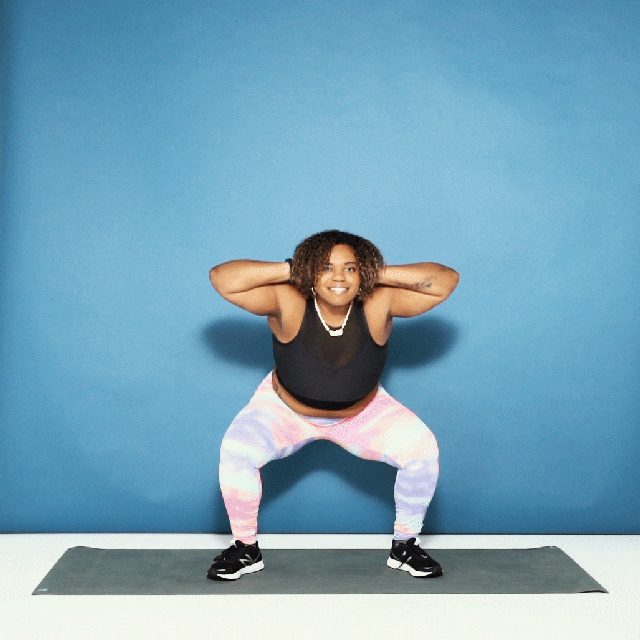
Katie Thompson
Importance to Volleyball Players:
The jump squat with heel tap is highly beneficial for volleyball players due to its focus on improving lower body strength, explosive power, and vertical jumping ability, which are essential for various aspects of the game.
- Spiking and Blocking: A strong and explosive lower body is vital for generating power in spikes and jumps for blocks.
- Vertical Jumping Ability: Enhancing the vertical jump through jump squats with heel taps can help players reach higher when spiking and blocking, making them more effective on the court.
- Agility and Quick Movement: The exercise improves agility and coordination, enabling players to move quickly to react to the ball and change direction rapidly.
- Injury Prevention: Strengthening the lower body can help to support and stabilize the joints, reducing the risk of common volleyball-related injuries, such as ankle sprains and knee injuries.
Incorporating jump squats with heel taps into a volleyball workouts routine can help players develop the necessary strength and power to excel in the sport, making it a valuable exercise for both beginner and advanced athletes.
5. Skater Hop
What is it?
The skater hop is a lateral plyometric exercise that targets the lower body, particularly the glutes, quadriceps, hamstrings, and calves. This exercise also engages the core and improves cardiovascular fitness. The movement mimics the side-to-side motion of a speed skater, enhancing lateral agility and explosiveness.
Benefits:
- Improved Lateral Agility: The skater hop focuses on side-to-side movement, enhancing lateral agility and quickness, which is essential for making rapid directional changes on the volleyball court.
- Increased Lower Body Strength: Engages major muscle groups in the lower body, leading to improved strength, muscle tone, and stability.
- Enhanced Explosive Power: The explosive nature of the movement helps develop fast-twitch muscle fibers, crucial for quick and powerful movements on the volleyball court.
- Cardiovascular Conditioning: The high-intensity nature of the exercise boosts heart rate and improves cardiovascular fitness.
- Core Engagement: The skater hop engages the core muscles, improving overall core strength and stability.
- Improved Balance and Coordination: The exercise challenges balance and coordination, enhancing overall athleticism and control on the court.
How to Do It:
- Starting Position: Stand upright with your feet hip-width apart, knees slightly bent, and arms at your sides.
- Hop to the Side: Push off your right foot and hop sideways to the left, landing softly on your left foot with your right foot behind your left ankle.
- Swing Arms: As you hop, swing your right arm across your body and your left arm behind your back.
- Repeat to the Other Side: Push off your left foot and hop sideways to the right, landing softly on your right foot with your left foot behind your right ankle.
- Continue Alternating Sides: Repeat the movement, hopping from side to side in a smooth and controlled manner.
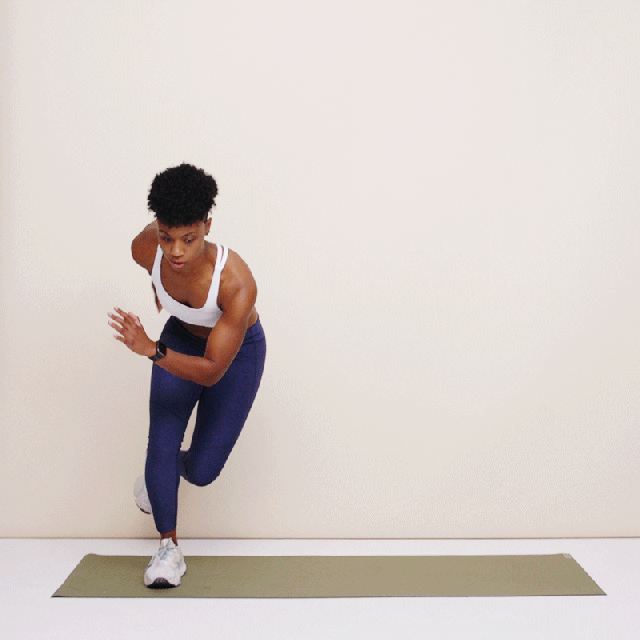
By Katie Thompson
Importance to Volleyball Players:
The skater hop is particularly beneficial for volleyball players due to its focus on improving lateral agility, explosive power, and overall athleticism, which are essential for various aspects of the game.
- Defensive Agility: Enhancing lateral agility through skater hops can help players to move quickly and effectively while defending against spikes and serves.
- Quick Directional Changes: The exercise improves the ability to make rapid directional changes, enabling players to react quickly to the ball and cover the court more efficiently.
- Lower Body Strength: Strengthening the lower body can help to support and stabilize the joints, reducing the risk of common volleyball-related injuries, such as ankle sprains and knee injuries.
- Improved Balance and Coordination: The exercise enhances overall balance and coordination, allowing players to maintain control during quick movements and changes in direction on the court.
Incorporating skater hops into a volleyball workouts routine can help players develop the necessary agility, strength, and power to excel in the sport, making it a good exercise for both beginner and advanced athletes.
6. Lateral Lunge to Single-Leg Hop
What is it?
The lateral lunge-to-single-leg hop is a dynamic plyometric exercise that combines a lateral lunge with an explosive hop on one leg. This exercise primarily targets the lower body, focusing on the glutes, quadriceps, hamstrings, and calves. Additionally, it engages the core and improves balance, coordination, and overall athleticism.
Benefits:
- Increased Lower Body Strength: Engages major muscle groups in the lower body, leading to improved strength, muscle tone, and stability.
- Enhanced Explosive Power: The explosive hop in the exercise helps develop fast-twitch muscle fibers, crucial for quick and powerful movements on the volleyball court.
- Improved Lateral Agility: The lateral lunge component of the exercise enhances lateral agility and quickness, which is essential for making rapid directional changes on the volleyball court.
- Core Engagement: The exercise engages the core muscles, improving overall core strength and stability.
- Improved Balance and Coordination: The combination of the lateral lunge and single-leg hop challenges balance and coordination, enhancing overall athleticism and control on the court.
- Cardiovascular Conditioning: The high-intensity nature of the exercise boosts heart rate and improves cardiovascular fitness.
How to Do It:
- Starting Position: Stand upright with your feet together and your hands on your hips.
- Lateral Lunge: Take a large step to your right side and lunge sideways, bending your right knee and pushing your hips back while keeping your left leg straight. Keep your chest up and your core engaged.
- Single-Leg Hop: From the lateral lunge position, push off your right foot and explode upwards into a hop, driving your left knee up towards your chest.
- Land Softly: Land on your right foot, bending your knee to absorb the impact, and return to the starting position.
- Repeat on the Other Side: Perform the lateral lunge to single-leg hop sequence on your left side, alternating legs for each repetition.
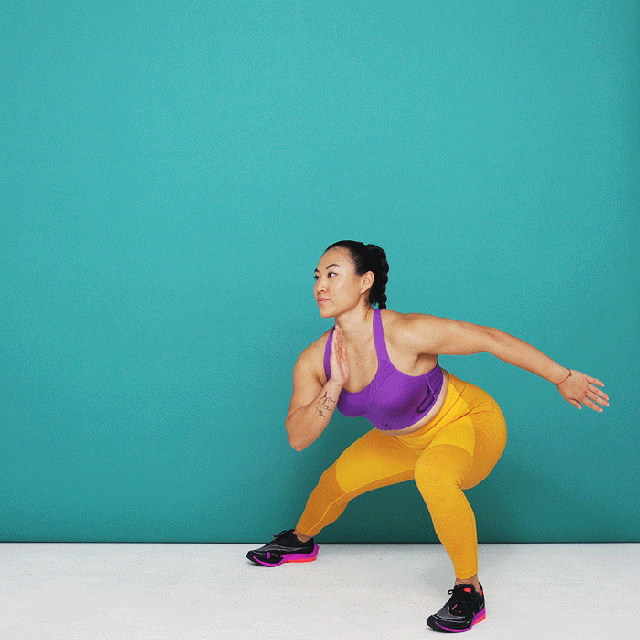
Katie Thompson
Importance to Volleyball Players:
The lateral lunge to single-leg hop is highly beneficial for volleyball players due to its focus on improving lower body strength, explosive power, lateral agility, and overall athleticism, which are essential for various aspects of the game:
- Spiking and Blocking: A strong and explosive lower body is vital for generating power in spikes and jumps for blocks.
- Defensive Agility: Enhancing lateral agility through lateral lunges can help players to move quickly and effectively while defending against spikes and serves.
- Quick Directional Changes: The exercise improves the ability to make rapid directional changes, enabling players to react quickly to the ball and cover the court more efficiently.
- Balance and Coordination: The exercise enhances overall balance and coordination, allowing players to maintain control during quick movements and changes in direction on the court.
- Injury Prevention: Strengthening the lower body can help to support and stabilize the joints, reducing the risk of common volleyball-related injuries, such as ankle sprains and knee injuries.
Incorporating lateral lunges and single-leg hops into a volleyball training routine can help players develop the necessary strength and power to excel in the sport, making it a valuable exercise for both beginner and advanced athletes.
See Also: Volleyball Positions Explained: A Comprehensive Guide for Players
7. Box Jump
What is it?
The box jump is a plyometric exercise that involves jumping onto a sturdy platform, typically a plyometric box. This exercise primarily targets the lower body, focusing on the glutes, quadriceps, hamstrings, and calves. It also engages the core and improves explosive power, vertical jump height, and overall athleticism.
Benefits:
- Increased Lower Body Strength: Engages major muscle groups in the lower body, leading to improved strength, muscle tone, and stability.
- Enhanced Explosive Power: The explosive nature of the movement helps develop fast-twitch muscle fibers, crucial for quick and powerful movements on the volleyball court.
- Improved Vertical Jump: Regularly performing box jumps can lead to an increase in vertical jump height, which is essential for spiking, blocking, and reaching high for digs and sets in volleyball.
- Core Engagement: The exercise engages the core muscles, improving overall core strength and stability.
- Improved Balance and Coordination: The exercise challenges balance and coordination, enhancing overall athleticism and control on the court.
- Cardiovascular Conditioning: The high-intensity nature of the exercise boosts heart rate and improves cardiovascular fitness.
How to Do It:
- Starting Position: Stand upright in front of a plyometric box with your feet shoulder-width apart, toes pointing forward, and arms at your sides.
- Preparation Jump: Perform a quick downward movement by bending your knees and swinging your arms back.
- Explosive Jump: Immediately swing your arms forward and jump explosively onto the plyometric box, extending your hips and knees fully to land with both feet on the box.
- Soft Landing: Land softly on the box with your knees slightly bent to absorb the impact.
- Step Down: Carefully step back down from the box, one foot at a time, or jump back down to the starting position.
- Repeat: Perform the box jump for the desired number of repetitions.
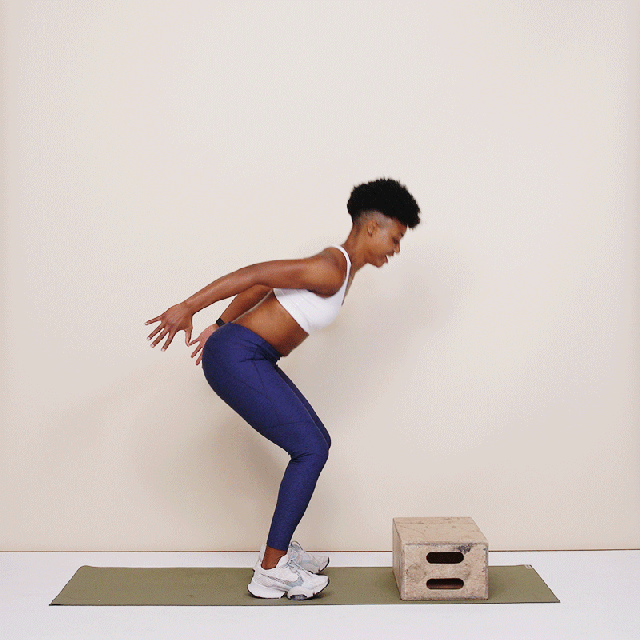
Katie Thompson
Importance to Volleyball Players:
The box jump is particularly beneficial for volleyball players due to its focus on improving lower body strength, explosive power, vertical jump height, and overall athleticism, which are essential for various aspects of the game.
- Spiking and Blocking: A strong and explosive lower body is vital for generating power in spikes and jumps for blocks.
- Defensive Agility: Enhancing explosive power through box jumps can help players move quickly and effectively while defending against spikes and serves.
- Increased Vertical Jump: Improving vertical jump height through box jumps can enable players to reach higher for blocks, spikes, and sets, giving them a competitive edge on the court.
- Balance and Coordination: The exercise enhances overall balance and coordination, allowing players to maintain control during quick movements and changes in direction on the court.
- Injury Prevention: Strengthening the lower body can help to support and stabilize the joints, reducing the risk of common volleyball-related injuries, such as ankle sprains and knee injuries.
Incorporating box jumps into a volleyball training routine can help players develop the necessary strength and power to excel in the sport, making it a valuable exercise for both beginner and advanced athletes.
8. Burpee
What is it?
The burpee is a full-body, functional exercise that combines a squat, push-up, and vertical jump into one fluid movement. This plyometric exercise targets multiple muscle groups, including the chest, shoulders, arms, core, glutes, quadriceps, and hamstrings. The burpee is known for its effectiveness in improving cardiovascular fitness, strength, and endurance.
Benefits:
- Full-Body Workout: Engages multiple muscle groups, providing a comprehensive workout in a single exercise.
- Cardiovascular Conditioning: It increases heart rate and improves cardiovascular fitness due to its high-intensity nature.
- Strength and Muscle Tone: Builds strength and muscle tone in the upper body, lower body, and core.
- Explosive Power: Enhances explosive power, essential for quick and powerful movements in sports like volleyball.
- Improved Coordination and Agility: challenges balance, coordination, and agility, improving overall athleticism.
- Calorie Burn: A high-calorie burning exercise that can aid in weight loss and weight management.
How to Do It:
- Starting Position: Stand upright with your feet shoulder-width apart.
- Squat Down: Bend your knees and lower into a squat position, placing your hands on the floor in front of you.
- Kick Back: Jump or step your feet back into a plank position, keeping your hands planted on the floor.
- Push-Up: Perform a push-up, lowering your chest towards the floor while maintaining a straight line from your head to your heels.Jump Forward: Jump or step your feet back to the squat position.
- Vertical Jump: Explosively jump into the air, reaching your arms overhead.
- Land and Repeat: Land softly and immediately lower back into the squat position to begin the next repetition.
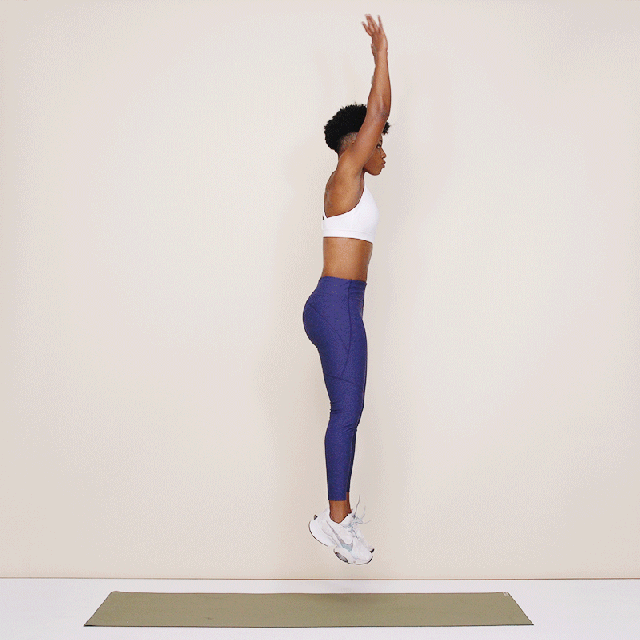
Katie Thompson
Important to volleyball players:
The burpee is an excellent exercise for volleyball players due to its full-body engagement, which can help improve overall athleticism, strength, and conditioning, crucial for various aspects of the game.
- Improved Cardiovascular Fitness: This enhances endurance and cardiovascular fitness, allowing players to maintain peak performance throughout the game.
- Enhanced Explosive Power: The explosive nature of the vertical jump in the burpee can help volleyball players improve their vertical jump height, which is essential for spiking, blocking, and reaching high for digs and sets.
- Full-Body Strength: Develops strength in the upper body, lower body, and core, supporting players in executing powerful spikes, blocks, and defensive moves.
- Agility and Coordination: challenges agility, balance, and coordination, enhancing a player’s ability to move quickly and effectively on the court.
- Calorie Burn and Weight Management: Aids in calorie burning and weight management, helping players to maintain optimal body weight and fitness level for the demands of the sport.
Incorporating burpees into a volleyball workouts routine can help players develop the necessary strength, power, and endurance to excel in the sport, making it a excellent exercise for both beginner and advanced athletes.
See Also:
- Top 10 Highest Paid Volleyball Players in the World (2024 update)
- How Much Do Volleyball Players Make?
Conclusion
Incorporating plyometric exercises into your volleyball training routine can significantly enhance your performance on the court. These explosive movements are designed to improve your jump height, agility, strength, and overall athleticism, all of which are crucial for excelling in volleyball.
Whether you’re aiming to spike higher, move faster, or reduce the risk of injury, plyometric workouts offer a targeted approach to achieving these goals.
By consistently practicing exercises like pop squats, split squat jumps, and box jumps, you’ll build the power and coordination necessary to outmaneuver opponents and perform at your best. Remember to prioritize proper form and gradually increase the intensity of your workouts to avoid injury. With dedication and the right approach, plyometric training can be a game-changer in taking your volleyball skills to the next level.

